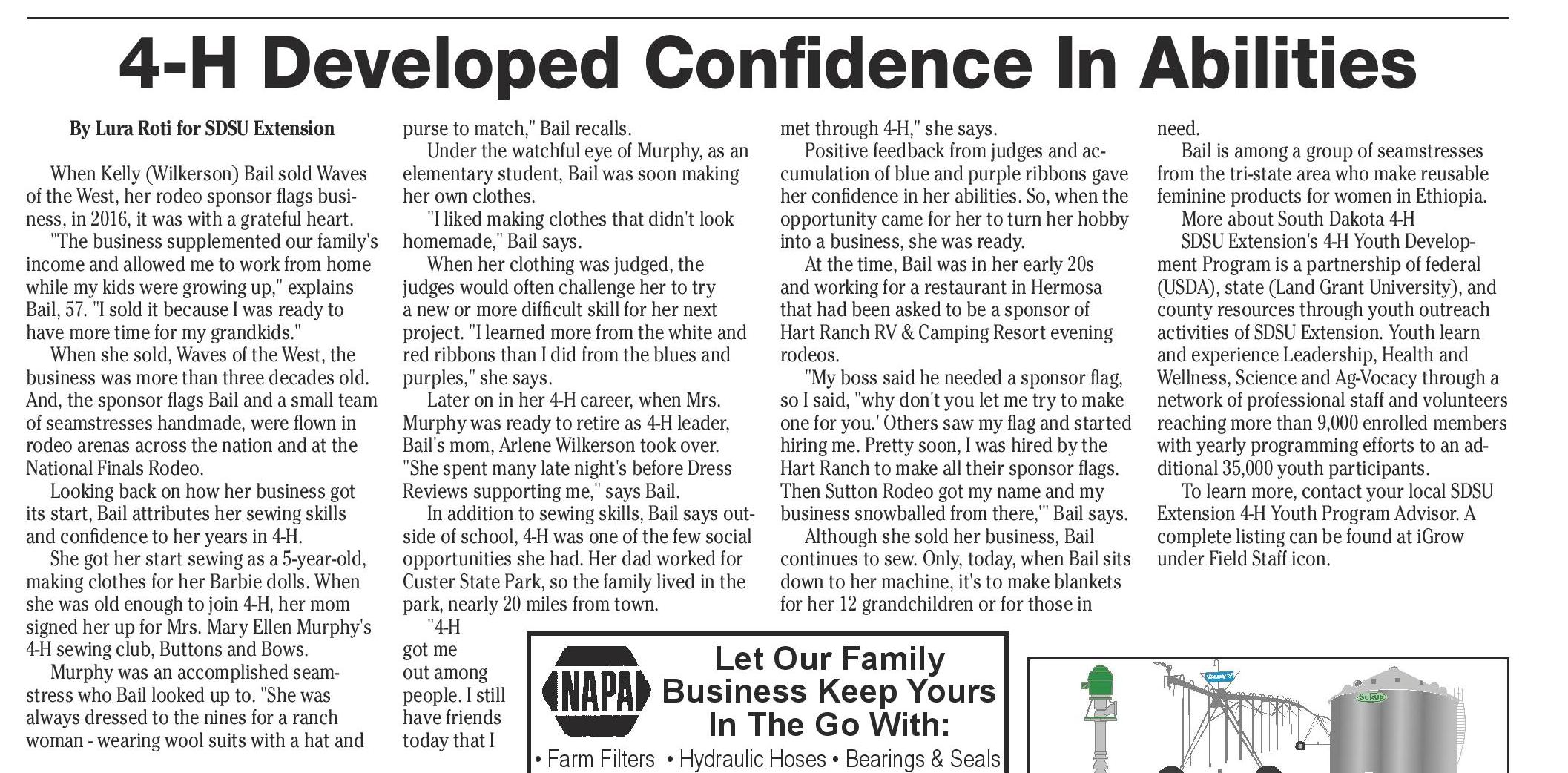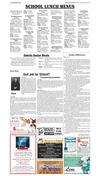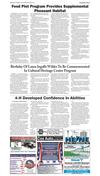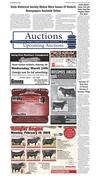021318_YKBP_A3.pdf








Broadcaster Press 3
February 13, 2018 www.broadcasteronline.com
Food Plot Program Provides Supplemental
Pheasant Habitat
BROOKINGS, S.D. - When considering
land management options for upland bird
habitat, a major limiting factor landowners
often find is nesting cover.
Food plots are one tool a landowner can
use to increase nesting cover. The term
food plot refers to small plots planted to
various crops or crop mixtures intended to
serve as forage for wildlife.
"If nesting cover is available in sufficient
quantities, then improving habitat components for chick survival and overwinter
survival can be beneficial for maintaining
healthy bird populations," explained Jimmy
Doyle, SDSU Extension Natural Resource
Management Field Specialist.
South Dakota Game, Fish & Parks Food
Plot Program
To assist landowners in providing winter
food sources for wildlife, South Dakota
Game, Fish & Parks (SDGFP) developed a
food plot program nearly 50 years ago.
Landowners can receive free corn,
sorghum seed or a brood mix to plant each
spring, plus a payment to help offset planting costs.
The brood mix has only been offered
since 2015, Doyle explained. "South Dakota's native wildlife typically don't starve
to death during a normal winter cycle, so
traditional grain-based food plots are more
of a novelty to wildlife than a necessity,"
Doyle said.
The mix was collaboratively developed
by biologists from Pheasants Forever and
South Dakota Game, Fish and Parks in an effort to increase the value of food plot acres
throughout the year.
"While traditional corn and sorghum
food plots offer excellent food sources during extreme winter months, they lack much
value to wildlife during other times of the
year," said Brian Pauly, Private Lands Biologist, SDGFP.
Developing the brood mix
In 2014, after two years of collaboration
the biologists tested the brood mix concept
on a handful of Game Production Areas
throughout the state.
The trial plantings were monitored
throughout the growing season, and observations were made to determine which
plant species performed ideally and which
did not.
Using those observations, a final seed
mix was developed for the inaugural planting season in 2015, when the brood mix was
first offered to the public as part of the food
plot program.
"The concept of growing habitat types
that benefit wildlife for more than just the
winter months was easily understood by
landowners," Pauly said.
He explained that those landowners
looking for a way to enhance pheasant
populations on their properties were eager
to try the new mix.
In its first three years 50 percent of all
landowners enrolled in the South Dakota
Game, Fish and Parks' food plot program
have tried the brood mix already.
What's in the brood mix?
The brood mix is an annual mixture of
cover crop species (i.e. canola, flax, millet,
radish, sunflower), designed to flower from
spring through fall and produce seed for
wildlife to forage on during winter.
By flowering, the brood mix provides
pollinator habitat that traditional corn and
sorghum food plots lack. Pollinating insects
(i.e. bees and butterflies) thrive in areas
with flowering plants.
Insects comprise nearly 100 percent of
a pheasant chick's diet, therefore making habitats with high insect numbers for
pheasant chicks to forage a key component
of pheasant production.
Simply put, more pollinating plants
equal more bugs equal more food for young
pheasants equal more roosters in the fall.
First and foremost, healthy pheasant
populations begin with large blocks of idle
grasslands for hens to nest in successfully
during spring. After hatching, pheasant
chicks rely on quality pollinator plants to
provide both insects for food, as well as
cover to hide from predators. The brood
mix offers landowners a way to provide
young pheasants the habitat they need to
survive between hatching on the grasslands
in the spring to fledging in the fall.
How should the brood mix be planted?
The brood mix can be planted anytime in
spring after the danger of frost has passed,
and it can be drill seeded or broadcasted
and drug in.
Typically, the month of May has been an
ideal time to plant the brood mix in previous years, but that may vary depending on
which part of the state a property is located
in and what weather trends are doing in a
particular year.
Before planting, it is important the site
is prepared properly. The brood mix cannot be sprayed with any chemicals once
it starts growing, so it is recommended to
plant this mix in an area that does not have
a current weed problem.
If planted in the right area, at the right
time, the plants will outcompete weeds
naturally, thus negating the need to spray
with chemicals at all. A long-term management plan by alternating food plots
between corn/sorghum and the brood mix
year-after-year will help to achieve clean,
weed-free pollinator habitat annually, yearin and year-out.
How can someone enroll in the SDGFP
food plot program?
SDGFP private lands biologists work
with landowners to enroll in the food plot
program.
Funding for these projects comes from
sales of hunting licenses, and landowners
must agree to allow free and reasonable
hunting access.
Landowners still retain and may regulate
all hunting access privileges on enrolled
lands; however they cannot charge anyone
a fee in exchange for hunting access.
To learn more about the food plot
program, or other wildlife habitat improvements, contact SDGFP or SDSU Extension.
Pheasant Fest is Feb. 16-18, 2018
For landowners, managers, hunters
or anyone interested in wildlife habitat
management, the upcoming Pheasant Fest
and Quail Classic in Sioux Falls is a great
opportunity to learn more.
Pheasant Fest runs from February 16-18,
2018 at the Denny Sanford Premier Center
in Sioux Falls. To learn more visit the Pheasants Forever website.
The event includes a trade show as well
as numerous seminars covering habitat
management, bird dog training, wild game
cooking, and more.
A workshop on the intersection of
precision agriculture, wildlife habitat, and
profitability will be of particular interest to
farmers and landowners.
Birthday Of Laura Ingalls Wilder To Be Commemorated
In Cultural Heritage Center Program
PIERRE, S.D. – The birthday of author
Laura Ingalls Wilder will be commemorated
at the Cultural Heritage Center in Pierre.
Caroline Fraser will speak remotely
about her book, “Prairie Fires: The American Dreams of Laura Ingalls Wilder” at 7
p.m. CST on Tuesday, Feb. 13.
“‘Prairie Fires’ was selected as one of
the New York Times Book Review’s 10 Best
Books of 2017. This program gives people the opportunity to learn the author’s
insights into the book,” said Catherine
Forsch, president of the South Dakota Historical Society Foundation.
The foundation, which is the nonprofit
fundraising partner of the South Dakota
State Historical Society, and the South Da-
kota Historical Society Press are sponsoring
the free program as part of the History and
Heritage Book Club. Everyone is welcome
to attend.
Wilder was born on Feb. 7, 1867. Her “Little House” books continue to shape ideas of
pioneer life on the American frontier in the
late 1800s.
Before “Little House in the Big Woods”
was published in 1932, Wilder had previously written a memoir of her life called
“Pioneer Girl” that publishers rejected. The
manuscript remained unpublished until
2014, when the SDHS Press published “Pioneer Girl: The Annotated Autobiography.”
“Pioneer Girl Perspectives” is a collection of essays edited by Nancy Tystad
Koupal, director of the Pioneer Girl Project,
and published by the SDHS Press. Fraser
contributed an essay to “Pioneer Girl Perspectives” that examines the relationship
between Wilder and her daughter, Rose
Wilder Lane.
The professional relationship between
Wilder and Lane is at the heart of “Prairie
Fires,” according to Fraser. She will discuss
this relationship during her talk on Feb. 13.
Fraser is editor of the Library of
America’s two-volume edition of Wilder’s
“Little House” books and has written about
Wilder and other topics for magazines and
other publications. She holds a doctorate in
literature from Harvard University.
People in De Smet, Wilder’s childhood
home, will be able to participate in the program at the De Smet Middle School through
the state’s video conferencing network.
They will be able to see, hear and talk to
Fraser and people at the Cultural Heritage
Center.
People in other locations who would like
the program broadcast to a location such
as a school or university on the DDN should
contact (605) 773-6006 for more information.
“Prairie Fires,” “Pioneer Girl” and “Pioneer Girl Perspectives” are all available at
the Heritage Stores at the Cultural Heritage
Center and the Capitol.
4-H Developed Confidence In Abilities
By Lura Roti for SDSU Extension
When Kelly (Wilkerson) Bail sold Waves
of the West, her rodeo sponsor flags business, in 2016, it was with a grateful heart.
"The business supplemented our family's
income and allowed me to work from home
while my kids were growing up," explains
Bail, 57. "I sold it because I was ready to
have more time for my grandkids."
When she sold, Waves of the West, the
business was more than three decades old.
And, the sponsor flags Bail and a small team
of seamstresses handmade, were flown in
rodeo arenas across the nation and at the
National Finals Rodeo.
Looking back on how her business got
its start, Bail attributes her sewing skills
and confidence to her years in 4-H.
She got her start sewing as a 5-year-old,
making clothes for her Barbie dolls. When
she was old enough to join 4-H, her mom
signed her up for Mrs. Mary Ellen Murphy's
4-H sewing club, Buttons and Bows.
Murphy was an accomplished seamstress who Bail looked up to. "She was
always dressed to the nines for a ranch
woman - wearing wool suits with a hat and
purse to match," Bail recalls.
Under the watchful eye of Murphy, as an
elementary student, Bail was soon making
her own clothes.
"I liked making clothes that didn't look
homemade," Bail says.
When her clothing was judged, the
judges would often challenge her to try
a new or more difficult skill for her next
project. "I learned more from the white and
red ribbons than I did from the blues and
purples," she says.
Later on in her 4-H career, when Mrs.
Murphy was ready to retire as 4-H leader,
Bail's mom, Arlene Wilkerson took over.
"She spent many late night's before Dress
Reviews supporting me," says Bail.
In addition to sewing skills, Bail says outside of school, 4-H was one of the few social
opportunities she had. Her dad worked for
Custer State Park, so the family lived in the
park, nearly 20 miles from town.
"4-H
got me
out among
people. I still
have friends
today that I
met through 4-H," she says.
Positive feedback from judges and accumulation of blue and purple ribbons gave
her confidence in her abilities. So, when the
opportunity came for her to turn her hobby
into a business, she was ready.
At the time, Bail was in her early 20s
and working for a restaurant in Hermosa
that had been asked to be a sponsor of
Hart Ranch RV & Camping Resort evening
rodeos.
"My boss said he needed a sponsor flag,
so I said, "why don't you let me try to make
one for you.' Others saw my flag and started
hiring me. Pretty soon, I was hired by the
Hart Ranch to make all their sponsor flags.
Then Sutton Rodeo got my name and my
business snowballed from there,'" Bail says.
Although she sold her business, Bail
continues to sew. Only, today, when Bail sits
down to her machine, it's to make blankets
for her 12 grandchildren or for those in
need.
Bail is among a group of seamstresses
from the tri-state area who make reusable
feminine products for women in Ethiopia.
More about South Dakota 4-H
SDSU Extension's 4-H Youth Development Program is a partnership of federal
(USDA), state (Land Grant University), and
county resources through youth outreach
activities of SDSU Extension. Youth learn
and experience Leadership, Health and
Wellness, Science and Ag-Vocacy through a
network of professional staff and volunteers
reaching more than 9,000 enrolled members
with yearly programming efforts to an additional 35,000 youth participants.
To learn more, contact your local SDSU
Extension 4-H Youth Program Advisor. A
complete listing can be found at iGrow
under Field Staff icon.
Let Our Family
Business Keep Yours
In The Go With:
• Farm Filters • Hydraulic Hoses • Bearings & Seals
605-202-9179
Cox Auto
1007 Broadway Ave
Yankton, SD
605•665•4494
VCDC Governmental Affairs Committee presents:
Cracker Barrels with your
Representatives
Locally Owned & Operated
Lawn | Landscape | Fence | Snow | Enhancement
Weekly Meat SpecialS
Fresh Pork Shoulder Roast..........
1
4 99
$ 29
$
lb.
Fresh Whole New York Strips......
Whole Ribeye’s...................... $ 99
Vermillion City Hall Council Chambers
Sponsored by Vermillion Area Chamber and
Development Company, League of Women Voters,
Clay County Republicans, Clay County Democrats
lb.
lb.
th
lb.
Irrigation PVC, Wire Installed, Well Drilling Domestic & Irrigation Pump Installation
WATERLINE & ELECTRIC TRENCHING
lb.
lb.
(16oz.)
SatuRday JanuaRy 27th
& FeBRuaRy 17th
9-11 am
lb.
5
79¢
¢
Or Chicken Thighs.............. 99
Fresh Choice Boneless $ 99
Chuck Roast......................... 2
2020 27 Street
$ 99
Sioux City, IA
Jamestown Bonless Hams... 1
712.258.5992
$ 29 www.laurencesmeat.com
Best Buy Bacon
........... 2
(Cut & PaCkaged Free)
Fresh Grade A
Jumbo Drumsticks...............
Irrigation
Sales & Service
Save-the-date:
Business Day at the Legislature
Thursday, February 22nd in Pierre
th Dakota
C Business Luncheon Series with Sou
VCD
r President, David Owen
Chambe
March 15th at 11:30am
Contact us for more information at vcdc@vermillionchamber.com
Tree & Concrete Removal, Site Clearing,
& Ditch Trenching
ALL TYPES OF DIRT WORK - FREE ESTIMATES
Bobcats • Crane • Dozers • Excavators • Grader
Grain Trailer • Scrapers • Side Dumps • Trenchers
Vermillion, SD (605)670-9567
Hartington, NE (402)254-2568
Licensed in SD, NE & IA



















 Previous Page
Previous Page






